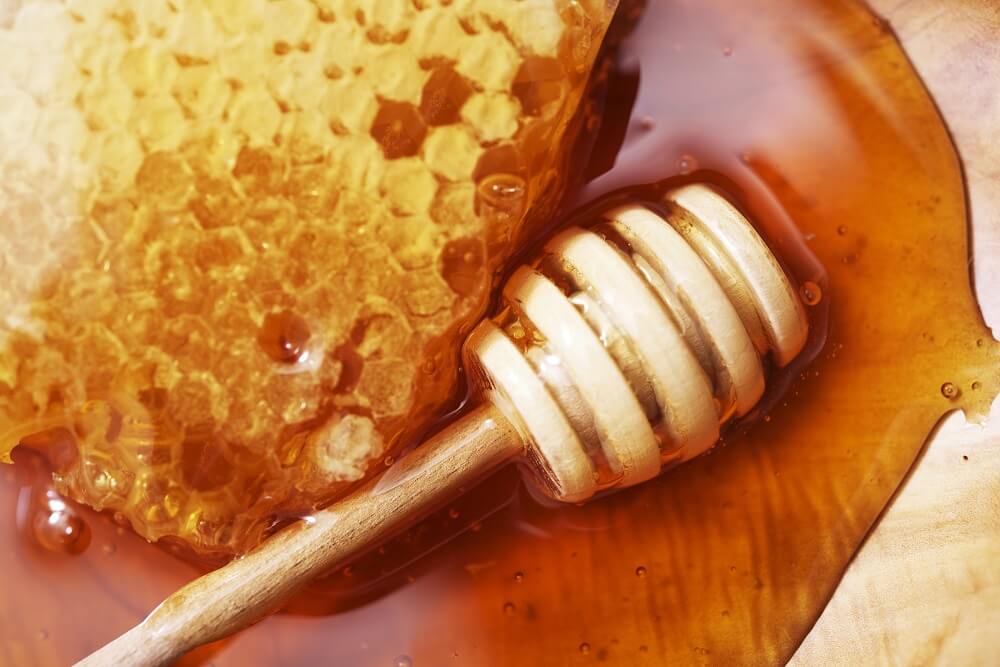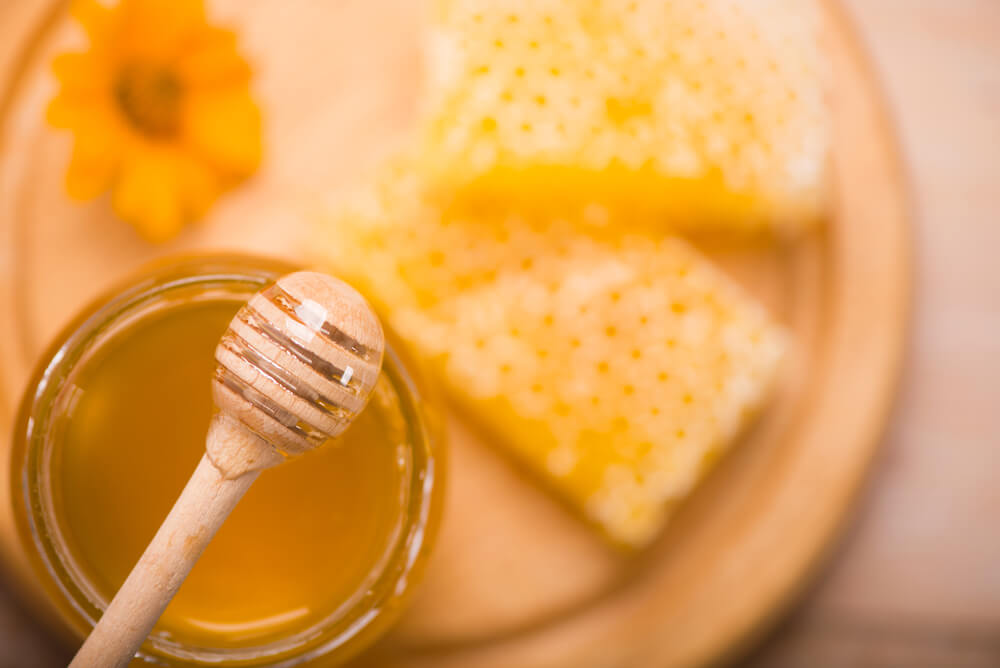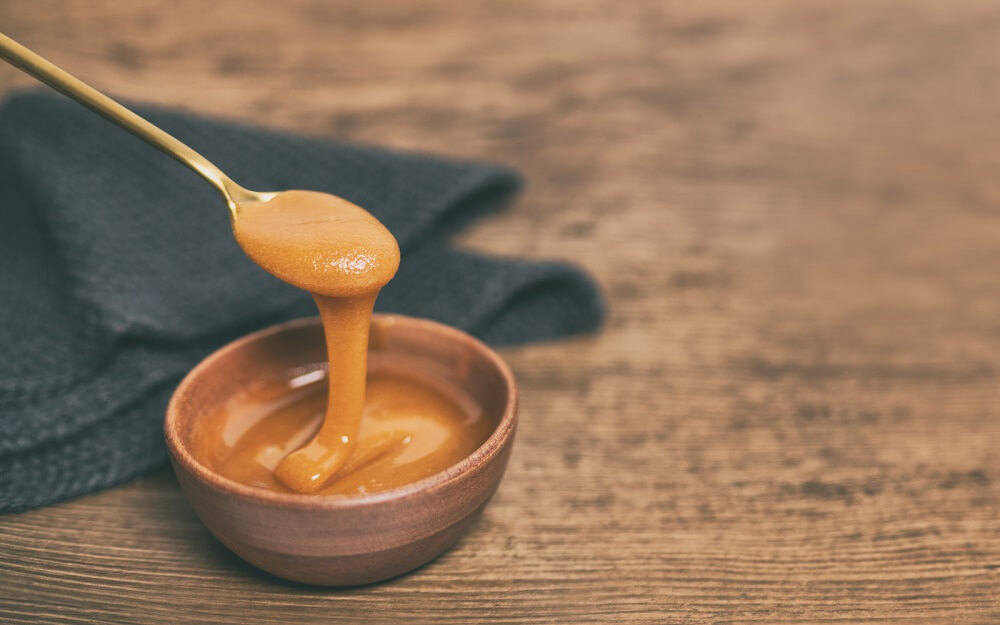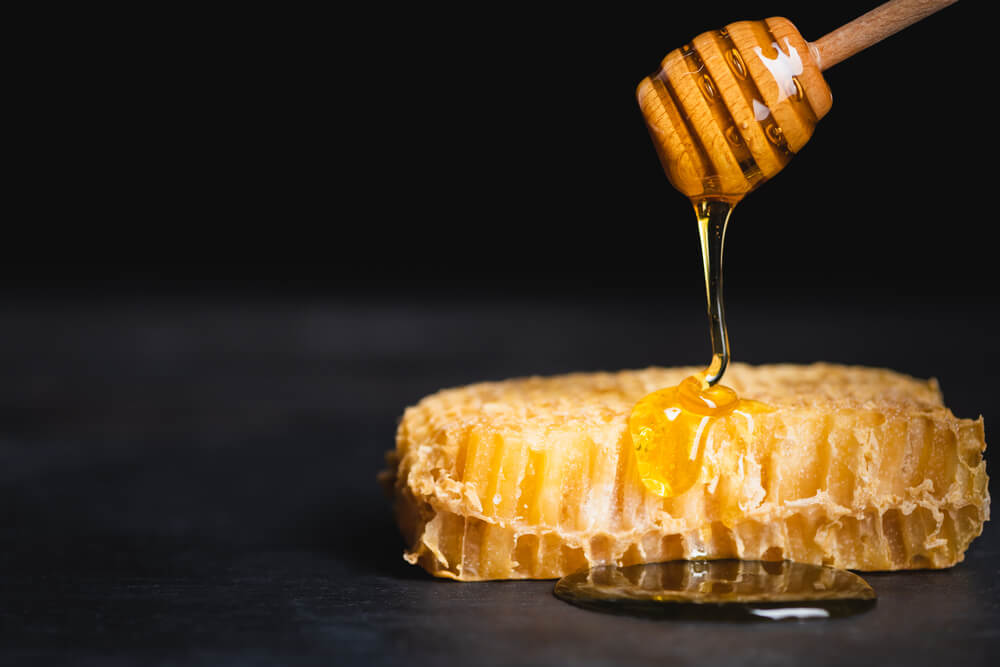Table of Contents:
What is Fireweed Honey?
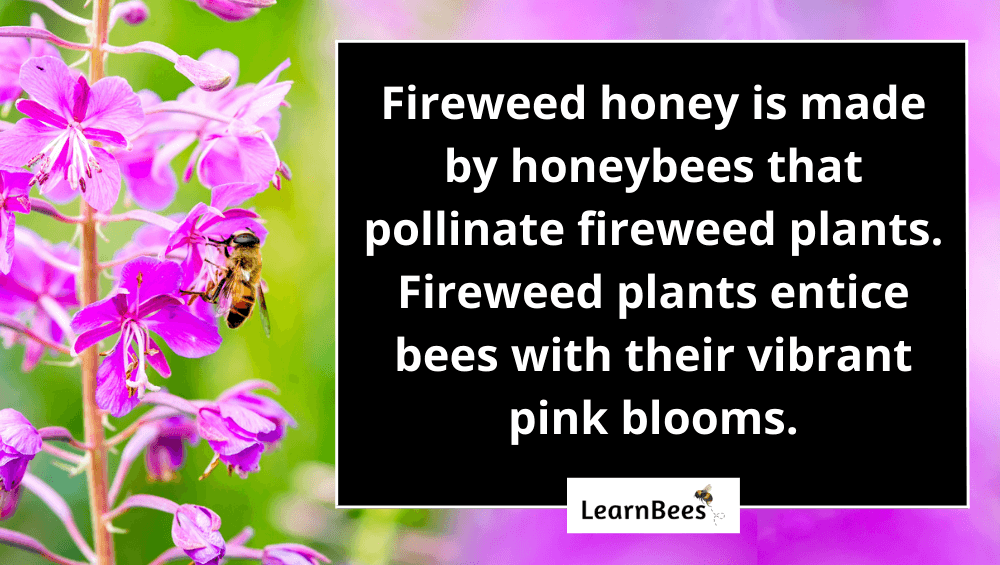
Fireweed honey is produced by honeybees that feed on fireweed plants.
Fireweed plants are tall, vibrant wildflowers that thrive in open meadows. Fireweed gets its name because it’s one of the first plants to grow after a major environmental event, like a forest fire.(1)
Honeybees are drawn like a magnet to the bright pink fireweed blossoms.
Speaking of honeybees, you might be wondering:
What does fireweed honey taste like?
Raw fireweed honey has a medium sweetness with a sharp, peppery undertone. It’s delicate and sweet with just a hint of spice.
The color is a medium golden, with a buttery texture that spreads nicely on warm toast or biscuits.
And the good news?
Raw honey has anti-inflammatory, antiviral, and antifungal properties. Because of this, honey has been successfully used in clinical settings to treat skin conditions such as psoriasis, eczema, and herpes lesions.(2, 3, 4)
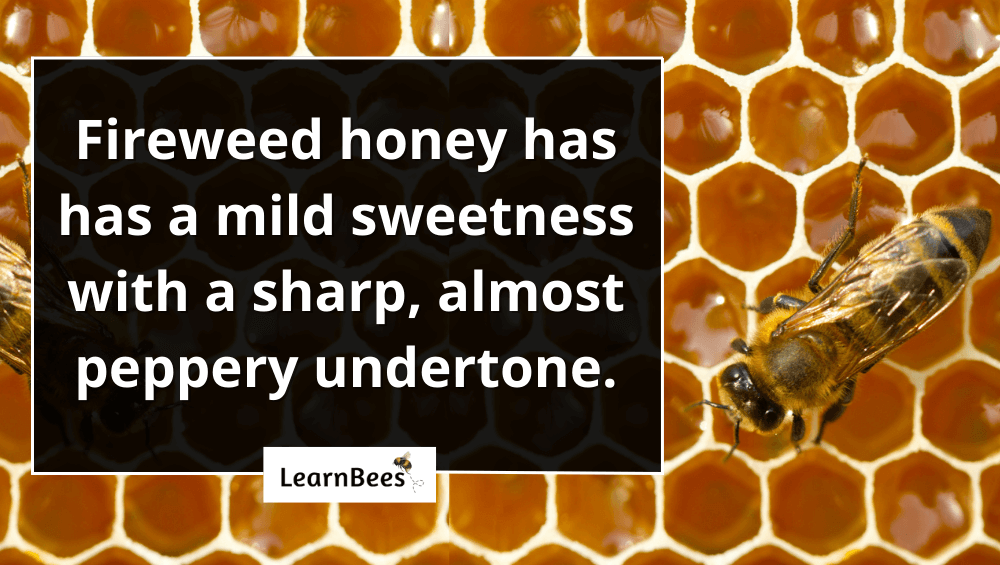
But remember:
Only raw honey provides these health benefits.
Raw fireweed honey is unprocessed and unpasteurized honey. It’s been preserved in its natural state, just as the honeybees created it.
Why does this matter?
Because pasteurized honey loses its antibacterial, anti-inflammatory, and antiviral properties. What’s more, some manufacturers add artificial sweeteners to their honey.(5, 6)
As such, the FDA warns that overly processed honey isn’t real honey.(7)
So here’s our advice:
Choose raw fireweed honey over the processed kind. This lets you reap the health benefits of raw honey while still enjoying the unique flavor.
And as a general rule?
Look for honey jars that say “raw” or “cold-pressed” on the label. This is how you know you’re getting the real thing.
What Are the Benefits of Fireweed Honey?
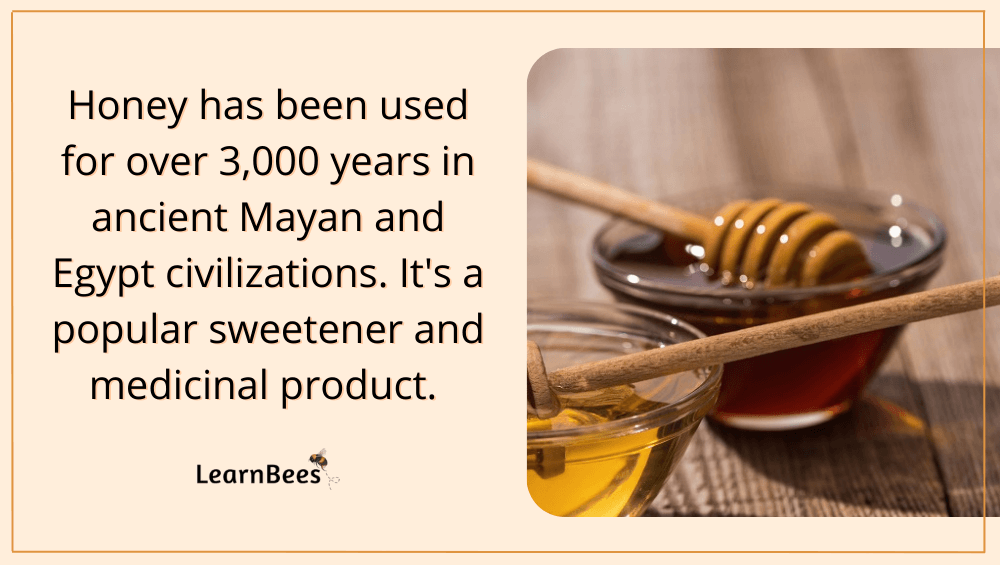
Fireweed Honey Nutrition
A single tablespoon of fireweed honey contains:
- Calories: 60 calories
- Protein: 0 grams
- Fat: 0 grams
- Carbs: 17 grams
- Sugars: 16 grams
So what are the fireweed honey benefits?
Here are a few:
Benefit 1: Honey is Packed With Antioxidants
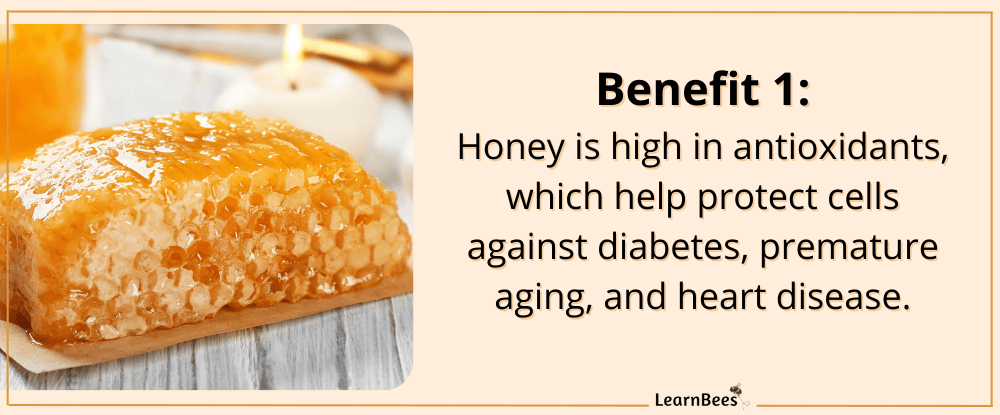
Honey includes antioxidants such as flavonoids and phenolic acids, which have been shown to protect against cell damage. Damage to cells can result in conditions such as type 2 diabetes, heart disease, and premature aging.(8)
Honey’s antioxidants have anti-inflammatory effects. Therefore, honey appears to be beneficial in preventing diseases associated with oxidative stress.(9)
Raw honey includes bee propolis and pollen, which provides more health advantages. Furthermore, according to studies, raw honey can positively impact the cardiovascular, respiratory, digestive, and nervous systems.(10)
Benefit 2: Honey Can Help With Skin Conditions and Injuries
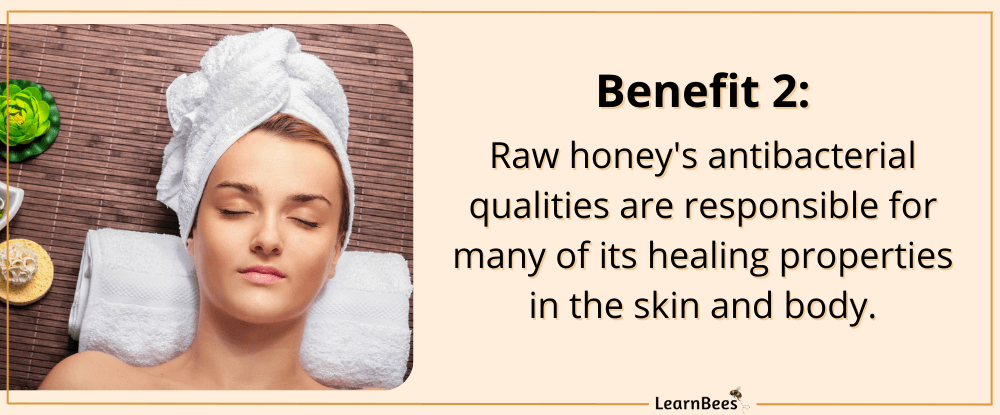
In a clinical setting, honey has been successfully used as a topical wound treatment. This is due to its antibacterial, antifungal, and anti-inflammatory properties.(11, 12)
Honey has also been shown to have antimicrobial qualities, which may prevent bacteria from spreading. As such, honey can help accelerate wound healing.(13, 14)
Honey was discovered in research to aid in the recovery of infections that develop after surgery.(15)
Raw honey has also been used to treat diabetes-related foot ulcers. Foot ulcers are open sores that develop at the base of the foot and can be quite serious. In some instances, they can lead to amputation.
According to one research, honey was found to have a 43.3% success rate of curing diabetes-related foot ulcers. Additionally, honey was found in a separate study to heal 97% of patients’ diabetes-related ulcers.(16)
Honey has also been found to aid in treating other skin problems, such as herpes sores and psoriasis.(17)
Benefit 3: Honey May Be Good for Your Heart

Raw honey has been shown in research to help lower the risk of heart disease.
According to one study of over 4,500 people, eating honey might help reduce the risk of high blood pressure.(18)
In another study, honey showed to lower blood pressure, regulate the heart, and boost blood fat levels. As a result, honey may help promote overall heart health.(19)
According to researchers, honey was found in a rat experiment to help prevent oxidative stress in the heart.(20)
Propolis, a chemical made by honeybees from sap-producing trees, is also found in raw honey. Propolis has been found to have triglyceride-lowering and cholesterol-lowering effects.(21)
Benefit 4: Honey is an Effective Treatment for Upper Respiratory Infections

Upper respiratory infections are associated with various symptoms, including sore throats and coughing fits. People who have upper respiratory illnesses may have trouble sleeping.
Raw honey has been proved to help cure sore throats and cough, with reports suggesting it might be a good substitute for cough medications.(22)
Honey has been found to be more effective than diphenhydramine (a cough medicine ingredient) in reducing coughing symptoms.(23)
Honey can help decrease cough duration by soothing the throat. As a result, honey has been found in several studies to help with upper respiratory infections.(24)
Honey has been shown to improve the quality of children’s and parents’ sleep by alleviating coughs, according to another study.(25)
Honey, unlike over-the-counter cough medicines, has no adverse side effects. That said, honey shouldn’t be fed to babies under one year old because of the risk of infant botulism.(26)
Once children are older than 12 months, they may consume honey safely.
What Are the Risks of Fireweed Honey?
Honey is typically safe to consume for the majority of people. Honey and honeycomb are low-risk foods.
But are there any side effects of fireweed honey?
Yes, there are two things to consider:
Risk 1: Honey Can Pose a Threat to Babies Under 12 Months

Honey is not recommended for children under one year of age since it can lead to infant botulism.
Infant botulism is a type of foodborne illness caused by Clostridium botulinum bacteria. It can harm the nervous system and cause paralysis and respiratory failure.
Due to their underdeveloped immune systems, babies may be vulnerable to botulism from honey.
That said, honey is considered safe for most children once they’re older than 12 months.
Risk 2: Honey Can Raise Blood Sugar Levels

“Is honey a healthier alternative to sugar?” is a question many people ask.
You’ve probably heard that honey is a superior sweetener to table sugar. While honey does have health benefits, it should be consumed in moderation by people with diabetes.
Honey, like other sugars, can raise blood sugar levels. It also includes carbohydrates which people using insulin need to be aware of.
FAQs on Fireweed Honey
- Does fireweed honey crystallize?
- What is fireweed honey good for?
- What is the taste of fireweed honey?
- Is fireweed honey pure honey?
- Does fireweed honey come from bees?
- Can you buy fireweed honey with honeycomb?
- Is fireweed honey in tea good?
- Is fireweed honey vegan?
- Can fireweed honey be used for weight loss?
- What color is fireweed honey?
- How do you take fireweed honey?
- Is fireweed honey safe?
- Is fireweed honey beneficial to the skin?
- Where can I buy fireweed honey?
- What’s the difference between fireweed honey vs. manuka honey?
Does fireweed honey crystallize?
Yes, all types of honey crystallize. The crystallization rate depends on the kind of honey and the storage conditions.
But don’t worry:
Crystallization is a natural process that happens to raw honey. It doesn’t mean that the honey has gone bad. In fact, some people enjoy their honey in this state because it has a chewy, gritty texture.
To decrystallize honey, simply place the jar in a pot of hot water and wait for the honey to liquify. You can stir the honey to help break up the honey crystals.
—> Go back to the FAQs on fireweed honey
More to Explore:
What is fireweed honey good for?
People often ask, “Does fireweed make good honey?”
Yes, fireweed honey has a unique taste that many people enjoy. The taste of fireweed honey is mildly sweet with spicy undertones.
You can add honey to tea, coffee, or use it as a natural sweetener in baking recipes. Fireweed honey has a bold flavor that pairs nicely with many foods.
Raw fireweed honey is also beneficial for treating sore throats, coughs, and skin wounds.
—> Go back to the FAQs on fireweed honey
More to Explore:
What is the taste of fireweed honey?
People frequently ask, “What does fireweed honey taste like?”
Fireweed honey tastes like a combination of sweet and peppery. This type of honey is delicious in tea, coffee, or used as a natural sweetener in recipes.
—> Go back to the FAQs on fireweed honey
More to Explore:
Is fireweed honey pure honey?
It depends. Raw fireweed honey is pure honey straight from the honeybee hive. However, some honey may be processed or pasteurized, which means it’s been heated and filtered. This type of processing can change the honey’s taste, color, and texture.
If you’re looking for pure, raw fireweed honey, check the label before purchasing. Raw honey comes with health benefits that processed honey does not.
—> Go back to the FAQs on fireweed honey
More to Explore:
- The Top 3 Best Manuka Honey Brands
- Orange Blossom Honey: Uses, Benefits, & Risks
- Sourwood Honey: Uses, Benefits, & Risks
Does fireweed honey come from bees?
People regularly ask:
Where does fireweed honey come from? Is fireweed good for bees?
Fireweed honey is made by bees that collect nectar from fireweed flowers. Fireweed is a type of wildflower that grows in many parts of the world, including North America, Europe, and Asia.
This flower is an essential food source for bees because it blooms later in the season when other flowers are scarce. Fireweed honey is a delicious, dark-colored honey that has a bold flavor.
—> Go back to the FAQs on fireweed honey
More to Explore:
Can you buy fireweed honey with honeycomb?
Yes, you can buy fireweed honey with the comb included. This type of honey is known as “cut comb” honey. The comb is edible and can be swallowed. Or, honeycomb can be spit out if you so choose.
The best place to buy fireweed honeycomb is from a local beekeeper. You may also be able to buy fireweed honeycomb online.
—> Go back to the FAQs on fireweed honey
More to Explore:
- The Brutally Honest Truth About Sour Honey
- Buckwheat Honey: Uses, Benefits, & Risks
- Can You Eat Honeycombs?
Is fireweed honey in tea good?
Yes, fireweed honey tea is a delicious and refreshing way to enjoy this type of honey. To make fireweed honey tea, simply add a spoonful of honey to a cup of hot tea. It’ll dissolve nicely and add additional sweetness.
—> Go back to the FAQs on fireweed honey
More to Explore:
Is fireweed honey vegan?
No, fireweed honey is not vegan because bees make it. Honey is considered an animal product because it comes from living creatures.
—> Go back to the FAQs on fireweed honey
More to Explore:
Can fireweed honey be used for weight loss?
Honey is generally not recommended for weight loss because it’s high in sugars, calories, and carbs.
However, raw honey does contain some vitamins, minerals, and antioxidants that may benefit overall health. But honey itself isn’t a weight loss aid.
—> Go back to the FAQs on fireweed honey
More to Explore:
- Do Honey Pasteurization Ruin Honey?
- Allergic to Honey: Signs of a Honey Allergy + Treatment
- Honey for the Face: Can You Apply it to the Skin?
What color is fireweed honey?
Fireweed honey is typically dark amber in color.
—> Go back to the FAQs on fireweed honey
More to Explore:
- Honey for Skin Benefits: Directions, Uses, & Risks
- 8 Scientific Benefits of Raw Honey
- Can You Eat Beeswax?
How do you take fireweed honey?
Fireweed honey can be eaten straight from the spoon or added to tea, coffee, or used as a natural sweetener in recipes. It has a bold flavor with a dash of peppery undertones.
Raw fireweed honey also has health benefits and can be used to treat sore throats, coughs, and skin wounds.
Remember that the health benefits of honey come from unprocessed, raw honey. Raw honey contains beneficial vitamins, minerals, and antioxidants.
—> Go back to the FAQs on fireweed honey
More to Explore:
- What Are Honeycombs Make Of?
- Beeswax on Hair: Benefits, Risks, & How to Use It
- Beeswax vs. Soy Wax: Which is Better for Candle Making?
Is fireweed honey safe?
Raw honey is generally safe for most people. However, babies under 12 months old should not consume raw honey because of the risk of botulism.
What is botulism?
Botulism is an uncommon but serious foodborne illness caused by a toxin that can sometimes be found in raw honey. Children under 12 months are at a higher risk for developing botulism because their immune system is not fully developed. Once the child is over 12 months old, they can safely eat honey.
Also, people with diabetes should be cautious when consuming honey because of the risk of a spike in blood sugar levels.
If you have any concerns, it’s best to speak with a doctor before consuming raw honey.
—> Go back to the FAQs on fireweed honey
More to Explore:
- Why is Manuka Honey So Expensive?
- Fermented Honey With Ginger Recipe
- What’s the Difference Between Raw and Organic Honey?
Is fireweed honey beneficial to the skin?
Yes, raw honey can be beneficial for the skin. It’s a natural humectant, meaning it helps keep the skin hydrated. Honey also has antibacterial and anti-inflammatory properties.
To use honey on the skin, simply apply it to the area and leave it on for a few minutes before rinsing off.
—> Go back to the FAQs on fireweed honey
More to Explore:
- Honey For Allergies: Is it a Potential Cure?
- What’s the Melting Point of Beeswax?
- Is Honey Acidic or Alkaline?
Where can I buy fireweed honey?
You can buy raw fireweed honey from your local beekeeper or an online retailer.
When purchasing honey, look for honey that says “raw” or “cold-pressed” on the label.
—> Go back to the FAQs on fireweed honey
More to Explore:
- Fermented Garlic and Honey Recipe
- Cinnamon Honey: Are There Health Benefits?
- How to Substitute Honey for Sugar
What’s the difference between fireweed honey vs. manuka honey?
Manuka honey comes from bees that pollinate the manuka tree in New Zealand. It’s known for its antibacterial and healing properties.
Fireweed honey is a type of honey that comes from the fireweed plant. It’s dark in color and has a bold flavor. It’s also known for its healing properties.
Both honey types are beneficial for the skin and can be used to treat wounds. They both have antibacterial properties and can help to keep the skin hydrated.
The main difference between the two kinds of honey is their origin. Manuka honey comes from New Zealand, and fireweed honey comes from the fireweed plant, which is found in several different countries.
With that in mind, there has been no scientific research comparing manuka honey to fireweed honey. As a result, it’s hard to say if one is better than the other.
